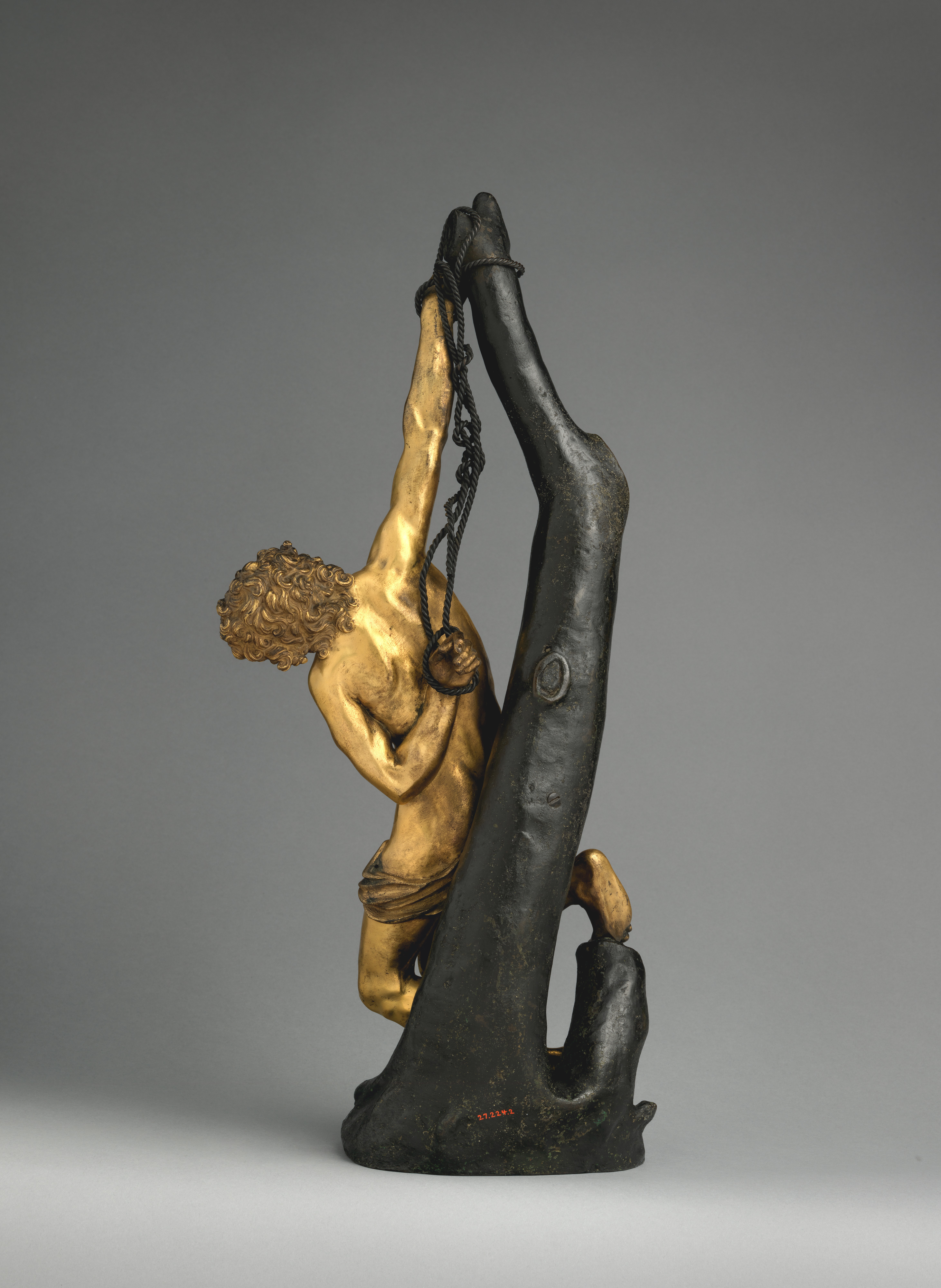Saint Sebastian
Possibly after a model by Pietro Tacca Italian
This dramatic composition of a naked Saint Sebastian hanging from a gnarled tree trunk by his bound wrist follows an extraordinarily successful model that is known through numerous versions and has been the subject of much art-historical debate.[1] The earliest documented extant casts are in the Liechtenstein and Este collections and the Louvre, but the inventories do not solve the problem of authorship.[2] The roster of candidates has included Georg Petel, François Duquesnoy, and Giovanni Francesco Susini. Scholarly consensus now falls on Pietro Tacca, Giambologna’s principal studio assistant and his successor as court sculptor to the Medici. The attribution is based on stylistic similarities to Tacca’s work as well as a link to Giambologna in the documentation. The first mention of the Saint Sebastian occurs in the inventory of merchant Paul von Praun’s collection, part of which was sent to his native Nuremberg from Bologna, where he died in 1616. Among the bronzes, we find: “6. A gladiator by Giambologna . . . 7. Saint Sebastian tied to a tree, 1 1/2 feet tall, by the same master.”[3] Another “Saint Sebastian” by Giambologna, along with a “mold of Saint Sebastian with the tree by J. Bellony [Giambologna],” is cited in the 1624 inventory of the Delft silversmith Thomas Cruse.[4] The fate of the Praun and Cruse statuettes is unknown, but it is likely they replicated the same model as our bronze, reinforcing the proposition that the prototype issued from Giambologna’s workshop, and more specifically from the hand of Pietro Tacca, his leading disciple. The most plausible explanation is that Tacca created the original model but did not the make all the known casts and variants.[5]
The presence of a small bronze and its mold in Cruse’s workshop testifies to the active circulation of copies well before 1624. The model’s popularity is confirmed by the existence of a terracotta version in the Stift Heiligenkreuz;[6] a model in the Doccia collection for reproduction in porcelain;[7] and its appearance in a painting by Adam de Coster titled Two Sculptors at Night in Rome from around 1620.[8] Interestingly, a number of early seventeenth-century paintings representing Saint Sebastian seem to follow the bronze composition, but their relationship to the sculptural model remains a conundrum.[9]
The Met’s Saint Sebastian, while finely cast, is not the best of the versions. The generalized features suggest a derivative late cast. The left hand seems to be solid, probably a result of a casting repair. A join is visible on the left ankle. The assemblage of figure, trunk, and rope is modern. The trunk is sand cast, thus not a Baroque piece but nineteenth century or later. In all probability it was copied from other versions that retained the original element.
-FL
Footnotes
(For key to shortened references see bibliography in Allen, Italian Renaissance and Baroque Bronzes in The Metropolitan Museum of Art. NY: The Metropolitan Museum of Art, 2022.)
1. For an overview, see Scholten and Verber 2005, pp. 78–81, with a list of some twenty known casts.
2. The Liechtenstein version was described in the 1658 inventory of Karl Eusebius; see Johanna Hecht in New York 1985, pp. 77–79, cat. 48. The Este statuette was recorded in 1684 (see Musei d’Italia 1878–80, vol. 3, p. 27). The example in the French royal collection (Louvre, MR 3274) must have been acquired by Louis XIV (Bion 1791, vol. 2, p. 261, no. 208; p. 251, no. 27, might be a second copy of the same bronze), but previously belonged to Cardinal Ludovico Ludovisi and was recorded in his 1623 inventory, as Gordon Balderston demonstrated (Scholten and Verber 2005, p. 78).
3. Murr 1797, p. 232: “6. Un gladiateur de Jean Bologne, 1 1/2 pied de hauteur, sur un piédestal garni de pierre précieuse; 7. St. Sébastien attaché à un arbre, 1 1/2 pied de hauteur, du même maître.” See Frankfurt 1986, p. 156.
4. Bredius 1915–22, vol. 4, p. 1457 (92): “[18] Noch een St. Bastiaen van J.B.”; and among the listed molds: “[23] De form van S, Sabasttyan mit de boom van J. Bellony.” See Scholten and Verber 2005, p. 78.
5. For comparisons with Tacca’s work, see Torriti 1984, pp. 80, 82, as well as the entry by Vanessa Montigiani in Falletti 2007, p. 176, cat. 24 (on a version owned by the Cassa di Risparmio di Carrara).
6. See Frey 1926, p. 233, no. 98, pl. 202. The monastery museum houses a collection of models by the sculptor Giovanni Giuliani, which has led some scholars to assign the Saint Sebastian to him, but the terracotta is clearly a copy of the bronze.
7. Lankheit 1982, p. 129, no. 29:35.
8. Statens Museum for Kunst, Copenhagen, KMSsp810; see Middeldorf 1978, fig. 9. In the painting, the figure holding the cast of Saint Sebastian is thought to be Georg Petel, prompting the disputed attribution of the original model to him. But Petel was still an adolescent in 1616, when Praun’s statuette was inventoried. Petel still might have cast a version based on that of another sculptor, possibly Tacca. His interest in Tacca is evident in his 1623 drawing of the latter’s Quattro Mori in Livorno. See Montigiani in Falletti 2007, p. 176.
9. Middeldorf 1978, p. 58, records examples in Santa Maria in Aquiro, Rome, and the Bayerische Staatsgemäldesammlungen, Munich. See also Cropper and Panofsky-Soergel 1984 and Scholten and Verber 2005, pp. 78–81.
Due to rights restrictions, this image cannot be enlarged, viewed at full screen, or downloaded.
This artwork is meant to be viewed from right to left. Scroll left to view more.



